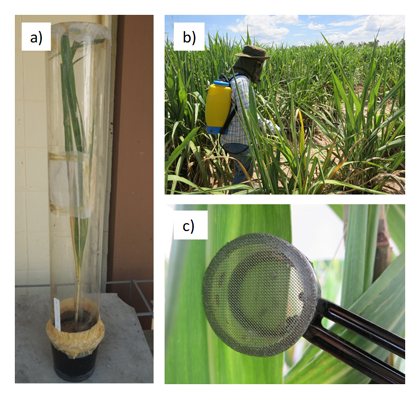An effective pesticide against the dominant insect vector of sugarcane white leaf disease
Description
Sugarcane white leaf (SCWL) disease is an insect-borne disease that severely affects sugarcane production in Southeast Asia, especially in Thailand. The pathogen is phytoplasma. Effective treatments against SCWL disease have not been developed yet, thus an integrated pest management system based on healthy seed cane production by meristem culture is being considered. However, SCWL disease has been spreading to healthy seed cane propagation fields due to transmission by the SCWL disease vector insect, Matsumuratettix hiroglyphicus, among others. Therefore, we screened insecticides and determined those that have shown high efficacy against M. hiroglyphicus, with the aim of developing an infection risk reduction technique targeting the insect vectors at healthy seed cane propagation fields.
Seven commercial insecticides from among registered insecticides in Thailand were applied on 2-month-old, healthy potted sugarcane plants in a greenhouse (Fig. 1a). Results showed that three of them (i.e., lambda-cyhalothrin 2.5% emulsifiable concentrate, thiamethoxam 25% water dispersible granule, and dinotefuran 1% granule) had long-term residual effects on the mortality of M. hiroglyphicus (Table 1). These three selected insecticides from the greenhouse condition test were applied on sugarcane fields (Fig. 1b), and the residual periods were evaluated using a small leaf cage (Fig. 1c). Data revealed that dinotefuran resulted in high mortality and that it had the longest-lasting residual effect among the three pesticides (Table 2). The impacts of the three insecticides on two natural enemies of sugarcane stem borers, Cotesia flavipes (Cameron) (larval parasitoid) and Trichogramma confusum Viggiani (egg parasitoid), were also evaluated, with the results of the experiments indicating that dinotefuran had no negative effects on the two natural enemies of M. hiroglyphicus (Table 3). From these results, we found that dinotefuran showed high efficacy against M. hiroglyphicus and that the impact to the natural enemies was not significant. Thus, this pesticide may be used toward developing techniques to reduce the risk of SCWL disease invasion by insect vectors on healthy seed cane at propagation fields.
Planting of healthy seed cane and managing the risks of invasion by insect vectors are essential to producing healthy seed cane at the propagation fields. The findings of this study contribute to the latter factor. To develop an appropriate chemical management technique, we need to understand the residual period of dinotefuran in each growth stage of sugarcane, and analyze the population dynamics and abundance estimation of M. hiroglyphicus. Moreover, the registration requirements must first be complied with before using dinotefuran for commercial application and treatment of sugarcane fields.
Figure, table
-
Fig. 1. Greenhouse (indoor) and field (outdoor) testing methods.
a) The pot used for the greenhouse condition test. The insect vectors were kept in the cage.
b) Sugarcane field for the field test. The plant height was about 160cm.
c) The small leaf cage for the field test. The diameter was 20mm. -
Table 1. Residual effect of pesticide treatments in M. hiroglyphicus mortality under laboratory condition Mortality ± S.E. (%) Chemical treatment 1 day after 7 days after 30 days after Carbaryl 85% WP 100 ±0a 100 ±0a 0 ±0b Carbosulfan 20% W/V EC 100 ±0a 100 ±0a 0 ±0b Carbofuran 3% GR 0 ±0b 40.6±6.0b 0 ±0b EPN 45% W/V EC 100 ±0a 100 ±0a 0 ±0b Lambda-cyhalothrin 2.5% W/V EC 100 ±0a 78.1±6.0a 6.3±6.3b Thiamethoxam 25% WG 100 ±0a 100 ±0a 87.5±5.1a Dinotefuran 1% GR 93.8±6.3a 100 ±0a 100 ±0a Distilled water 3.1±3.1b 0 ±0c 0±0b The pesticides were applied on two-month-old potted plants and the insect vectors were released 1 day, 7 days and 30 days after the treatment.
The numbers indicate the mortality rates 48 hours after pesticide treatment.
Values with different letters within columns indicate significant difference based on Tukey's honest significant difference test (P<0.05). -
Table 2. Residual effect of selected pesticide treatments in M. hiroglyphicus mortality under field condition Mortality ± S.E. (%) Chemical treatment 1 day after 7 days after 30 days after 60 days after Lambda-cyhalothrin 2.5% W/V EC 34.7±18.5b 4.0±2.3b 1.3± 1.3b 2.7± 1.3ab Thiamethoxam 25% WG 100 ± 0a 98.6±1.3a 30.7±10.4a 9.3± 5.8ab Dinotefuran 1% GR 98.7±1.3a 100 ±0a 98.7± 1.3a 49.3±13.1a Distilled water 5.3±2.7b 1.3±1.3b 2.7± 2.7b 1.3± 1.3b The pesticides were applied on 6- to 7-month-old plants and the insect vectors were released 1 day, 7 days, 30 days and 60 days after the treatment.
The numbers indicate the mortality rates 48 hours after pesticide treatment.
Values with different letters within columns indicate significant difference based on Tukey's honest significant difference test (P<0.05). -
Table 3. Residual effect of the selected pesticides to C. flavipes and T. confusum C. flavipes T. confusum Mortality ± S.E. (%) Mortality ± S.E. (%) Chemical treatment 1day after 7days after 30days after 1day after 7days after 30days after Lambda-cyhalothrin 2.5% W/V EC 79.0±6.4a 11.0±8.6a 5.0±1.6a 73.0±3.4b 20.5±3.0b 11.0±3.3a Thiamethoxam 25% WG 65.0±5.0a 8.0±2.0a 8.0±2.6a 98.0±2.0a 41.5±7.2a 12.0±3.7a Dinotefuran 1% GR 6.0±1.9b 4.0±1.9a 2.0±1.2a 17.0±3.7c 14.0±2.0b 5.0±2.2a Distilled water 1.0±1.0b 2.0±1.2a 0 ±0a 10.0±2.2c 9.5±2.2b 3.0±2.0a The pesticides were applied on five-month-old potted plants and the insects were released 1 day, 7 days and 30 days after the treatment.
The numbers indicate the mortality rates 48 hours after pesticide treatment.
Values with different letters within columns indicate significant difference based on Tukey's honest significant difference test (P<0.05).
- Affiliation
-
Japan International Research Center for Agricultural Sciences Tropical Agriculture Research Front
- Research project
- Program name
- Term of research
-
FY2017(2014~2018)
- Responsible researcher
-
Kobori Youichi ( Tropical Agriculture Research Front )
Ando Shotaro ( Tropical Agriculture Research Front )
Hanboonsong Y. ( Faculty of Agriculture, Khon Kaen University )
- ほか
- Publication, etc.
-
https://doi.org/10.1007/s12355-017-0516-8
Hanboonsong Y and Kobori Y (2017) Sugar Tech, 19: 573–578
- Japanese PDF
-
A4 313.34 KB
A3 279.13 KB
- English PDF
-
A4 176.45 KB
A3 169.54 KB
- Poster PDF
-
2017_B12_poster.pdf368.83 KB

